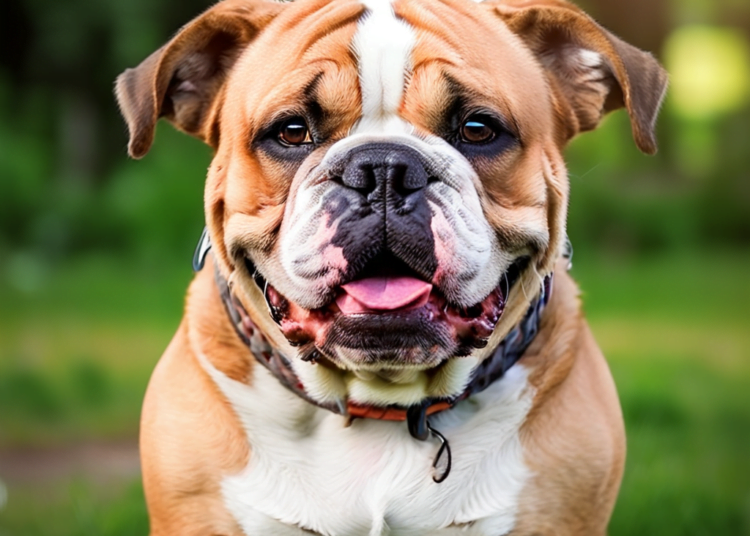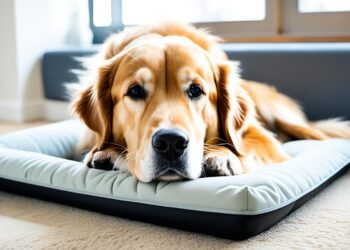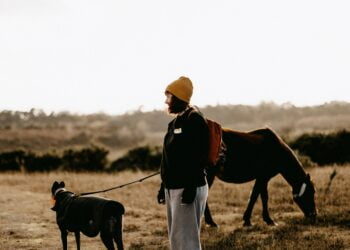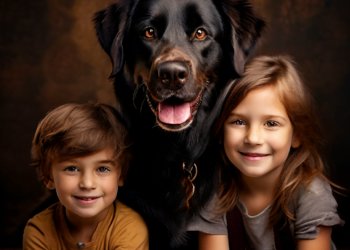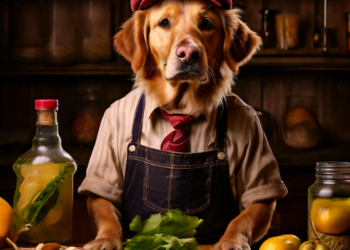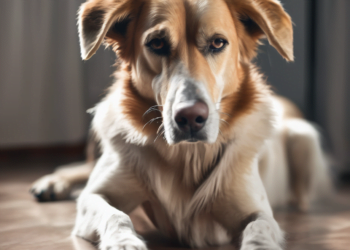This comprehensive guide will provide expert advice on properly caring for your Bulldog. From understanding the unique characteristics of the Bulldog breed to training tips and health considerations, we will cover everything you need to know to ensure your loyal companion thrives.
Key Takeaways:
- Understanding the distinct physical and temperamental traits of the Bulldog breed is essential for providing proper care.
- Bulldogs require regular grooming, exercise, and mental stimulation to maintain their health and well-being.
- Proper nutrition is crucial for the overall health and longevity of Bulldogs.
- Training techniques tailored to Bulldogs can help establish well-behaved and obedient companions.
- Bulldogs are prone to certain health issues, and regular veterinary check-ups are important for early detection and prevention.
Table of Contents
Understanding the Bulldog Breed
Bulldogs are a unique breed with distinct physical and temperamental traits that set them apart from other breeds. This section will explore Bulldogs’ history, appearance, and temperament, providing a deeper insight into their unique characteristics.
| Aspect | Description |
|---|---|
| History | The Bulldog breed originated in England and was originally bred for bull-baiting. However, after the bloodsport was abolished, the breed’s temperament was transformed, and Bulldogs became known for their gentle and loyal nature. |
| Appearance | Bulldogs have a distinctive appearance characterized by their muscular build, broad head, and wrinkled face. They have a short, smooth coat and come in various colors, including brindle, white, fawn, and piebald. |
| Temperament | Bulldogs are known for their friendly, calm, and affectionate nature. They are excellent family pets, often forming strong bonds with their owners. Despite their sturdy appearance, Bulldogs are typically laid-back and not overly active. |
Understanding the Bulldog breed’s history, appearance, and temperament will help you navigate their unique needs and provide the best care possible. In the following sections, we will explore the essential aspects of Bulldog care.
Bulldog Care Essentials
Providing proper care is essential for the overall well-being of your Bulldog. Understanding their needs and following appropriate care routines ensures your loyal companion remains healthy and happy. This section will outline the key aspects of Bulldog care that every owner should know.
Grooming Routine
Regular grooming is crucial for maintaining your Bulldog’s hygiene and appearance. Due to their short, dense coats, Bulldogs are relatively low-maintenance in grooming. However, they still require regular brushing to remove loose hair and prevent matting. Additionally, paying attention to their facial wrinkles is essential to prevent infection and irritation. Cleaning these wrinkles with a damp cloth and keeping them dry will help keep your Bulldog’s skin healthy.
Here is a snapshot of a typical grooming routine for Bulldogs:
| Grooming Task | Frequency |
|---|---|
| Brushing | Weekly |
| Bathing | Once every 3-4 months or as needed |
| Cleaning facial wrinkles | Daily |
| Nail trimming | Every 4-6 weeks |
| Ear cleaning | Weekly |
Nutrition and Feeding Habits
Proper nutrition is vital for supporting your Bulldog’s overall health and vitality. Bulldogs tend to gain weight easily, so monitoring their food intake is important and ensuring they maintain a healthy weight. Feeding your Bulldog a balanced diet of high-quality, age-appropriate dog food is crucial.
Consider these feeding guidelines for Bulldogs:
- Provide your Bulldog with a nutritious formula that meets their specific dietary needs.
- Divide their daily food intake into two or three smaller meals to avoid digestive issues and help control weight.
- Avoid overfeeding and monitor their weight regularly to prevent obesity.
- Provide fresh water at all times and keep their feeding area clean.
Exercise and Mental Stimulation
While Bulldogs have a laid-back nature, they still require regular exercise and mental stimulation to keep them healthy and happy. Engaging in physical activities and providing mental challenges can help prevent obesity and boredom-related behavior issues.
Here are some exercise and mental stimulation ideas for Bulldogs:
- Take daily walks to provide moderate exercise and fresh air.
- Engage in interactive play sessions that stimulate their instincts.
- Introduce puzzle toys or food-dispensing toys to provide mental stimulation while feeding.
- Consider enrolling your Bulldog in obedience training or agility classes to provide structured exercise and mental challenges.
By following these Bulldog care essentials, you can provide the best possible care for your beloved companion, ensuring their health, happiness, and longevity.
Nurturing Bulldog Puppies
When considering adding a Bulldog puppy to your family, it’s crucial to understand the key aspects of caring for them during their early months. Proper care and attention set the foundation for a happy and healthy adult Bulldog during this critical development stage. This section will guide you through the essential steps in nurturing Bulldog puppies, including socialization, training, and nutrition.
Socialization for a Well-Adjusted Bulldog
Socialization is a vital part of raising a Bulldog puppy. Introducing them to various environments, people, and other animals at a young age helps them develop positive behaviors and reduces the risk of anxiety and aggression in adulthood. Here are some tips for successful socialization:
- Expose your puppy to different sights, sounds, and experiences.
- Arrange playdates with other friendly, vaccinated dogs.
- Introduce your Bulldog to new people and encourage gentle handling.
- Enroll them in puppy obedience classes to enhance socialization skills.
Training for a Well-Behaved Bulldog
Bulldogs are intelligent dogs but can be stubborn at times. Consistent and positive training techniques are essential to establish good behavior patterns. Here are some training tips to consider:
- Start with basic obedience commands like sit, stay, and come.
- Use reward-based training methods, such as treats and praise.
- Keep training sessions short and engaging to hold your puppy’s attention.
- Be patient and consistent, reinforcing positive behaviors and redirecting unwanted ones.
Proper Nutrition for Healthy Growth
Feeding your Bulldog puppy a balanced diet is crucial for their growth and development. Opt for high-quality puppy food formulated for Bulldogs to meet their unique nutritional needs. Consult your veterinarian for specific feeding guidelines based on your puppy’s age and activity level.
Expert Tip: Avoid overfeeding Bulldog puppies, as they are prone to weight gain. Monitor their portions and provide regular exercise to keep them at a healthy weight.
During the first few months, feed your Bulldog puppy small, frequent meals to prevent bloating, a condition common in the breed. As they grow, they gradually transition to scheduled mealtimes.
By understanding the importance of socialization, implementing effective training techniques, and providing appropriate nutrition, you can ensure your Bulldog puppy grows into a well-rounded and thriving adult companion. With love, patience, and proper care, your Bulldog puppy will fill your life with joy and loyalty for years.
Bulldog Training Techniques
Training your Bulldog is an essential part of their care. Bulldogs are known for their strong-willed nature, which can sometimes present challenges during training. However, you can establish a well-behaved and obedient companion with the right techniques and consistency. Here, we will provide you with effective Bulldog training techniques specifically tailored to the needs of this breed.
Socialization: The Foundation of Training
One of the first steps in Bulldog training is socialization. Early socialization exposes your Bulldog puppy to various people, animals, and environments, helping them develop positive behaviors and confidence. Gradually introduce your puppy to sights, sounds, and experiences to prevent fear or aggression.
Tip: Enroll your Bulldog puppy in puppy socialization classes or arrange playdates with other friendly dogs to encourage healthy social interactions.
Positive Reinforcement: Motivating Your Bulldog
Positive reinforcement is a highly effective training technique for Bulldogs. This method involves rewarding your Bulldog with treats, praise, or play whenever they exhibit desired behaviors. Use a calm and friendly tone when giving commands, and reward them promptly when they respond correctly. This will reinforce the positive association between good behavior and rewards.
Tip: Choose small, easy-to-swallow treats that your Bulldog loves. Break them into smaller pieces to reward your Bulldog frequently during training sessions without overfeeding them.
Consistency and Patience: Key Training Principles
Consistency and patience are vital when training Bulldogs. Bulldogs are intelligent but stubborn sometimes, so it’s important to remain calm and patient throughout training. Be consistent in your commands, gestures, and expectations to avoid confusion. Short, frequent training sessions are more effective than long, exhausting ones.
“The key to successful training lies in consistent practice, patient instruction, and understanding your Bulldog’s unique personality.”
Basic Commands: Building a Strong Foundation
Teaching your Bulldog basic commands lays a solid foundation for further training. Start with essential commands such as “sit,” “stay,” “come,” and “down.” Use positive reinforcement and repetition to help your Bulldog understand and respond to these commands consistently. Remember to keep training sessions fun and engaging to maintain your Bulldog’s interest.
Addressing Behavioral Challenges
Occasionally, Bulldogs may exhibit behavioral challenges that require additional training and attention. Consistent training techniques and redirection can address common issues such as jumping, excessive barking, or leash pulling. Seeking professional help from a certified dog trainer may also be beneficial in addressing specific behavioral challenges.
| Training Tip | Description |
|---|---|
| Avoid Harsh Punishments | Training through positive reinforcement is more effective than using punishment-based methods. Harsh punishments can damage the trust and bond between you and your Bulldog. |
| Use Clicker Training | Clicker training is a popular method that combines positive reinforcement with a distinct sound from a clicker device. It helps reinforce desired behaviors and allows for precise timing during training sessions. |
| Be Firm and Establish Boundaries | While positive reinforcement is important, it’s essential to establish boundaries and be firm when necessary. Consistent boundaries help your Bulldog understand what is expected of them. |
Training Resources
Various resources are available to assist you in your Bulldog’s training journey. Books, online courses, and professional dog trainers can provide valuable guidance and support. Additionally, joining local Bulldog owner groups or forums can connect you with fellow Bulldog owners and provide a platform to share tips and experiences.
By employing these effective Bulldog training techniques and maintaining a positive and consistent approach, you’ll build a strong bond with your Bulldog and ensure they become a well-mannered and obedient companion.
Maintaining Bulldog Health
Ensuring the health and well-being of your Bulldog should be a top priority. Bulldogs are prone to certain health issues, so being proactive in their care is crucial. From regular veterinary check-ups to addressing common health concerns, here’s everything you need to know to keep your Bulldog in optimal health.
Regular Veterinary Check-ups
Regular visits to the veterinarian are essential for monitoring your Bulldog’s overall health and catching any potential issues early on. A trusted veterinarian will perform thorough examinations, administer vaccinations, and provide guidance on preventive measures specific to Bulldogs. Maintaining up-to-date vaccinations and preventive treatments can help protect your Bulldog from infectious diseases.
Common Bulldog Health Concerns
Bulldogs have certain breed-specific health concerns that owners should be aware of. Some common health issues that Bulldogs may face include:
- Brachycephalic Airway Syndrome: Bulldogs have a short, flat nose, which can lead to respiratory difficulties.
- Joint and Bone Problems: Bulldogs are prone to hip dysplasia, elbow dysplasia, and other orthopedic issues.
- Skin Allergies: Bulldogs are susceptible to skin allergies, which can cause itching, redness, and discomfort.
- Eye Problems: Cherry eye, dry eye, and other eye conditions are common in Bulldogs.
- Heat Sensitivity: Bulldogs can struggle with heat regulation due to their brachycephalic nature.
It’s important to educate yourself about these potential health concerns and take appropriate measures to prevent, manage, or seek treatment as necessary. Regularly monitoring your Bulldog’s health and being attentive to changes in behavior or physical appearance can help you identify issues early on.
Proactive Care and Exercise
Beyond regular veterinary care, you can take several proactive measures to maintain your Bulldog’s health. These include:
- Providing a balanced diet: Opt for high-quality dog food that meets your Bulldog’s nutritional needs and supports their optimal health.
- Maintaining a healthy weight: Obesity can exacerbate many health issues, so it’s essential to ensure your Bulldog stays healthy.
- Regular exercise: Despite their brachycephalic nature, Bulldogs still require daily exercise to keep them physically fit and mentally stimulated. However, avoiding overexertion or exercising them in extreme temperatures is important.
- Dental care: Bulldogs are prone to dental problems, so regular teeth brushing and veterinary dental cleanings are crucial for oral health.
By implementing these proactive measures and being attentive to your Bulldog’s specific needs, you can significantly contribute to their overall health and well-being.
| Health Concern | Preventive Measures |
|---|---|
| Brachycephalic Airway Syndrome | Limit exposure to extreme temperatures, avoid strenuous exercise in hot weather, and ensure proper weight management to reduce strain on the respiratory system. |
| Joint and Bone Problems | Provide a balanced diet rich in essential nutrients for bone health. Avoid excessive jumping or activities that can put strain on joints. |
| Skin Allergies | Maintain a clean and hypoallergenic environment, use gentle grooming products, and consult with a veterinarian for allergy testing and appropriate treatment. |
| Eye Problems | Maintain a clean and hypoallergenic environment, use gentle grooming products, and consult a veterinarian for allergy testing and appropriate treatment. |
| Heat Sensitivity | Avoid excessive heat exposure, provide ample shade and fresh water, and never leave your Bulldog unattended in a hot environment. |
Combating Bulldog Temperament Issues
Despite their reputation for being gentle and loyal, Bulldogs may occasionally display temperament issues. Owners need to address these behavioral challenges promptly and effectively. Here are some tips and strategies to help you manage and overcome Bulldog temperament issues:
1. Early Socialization
Proper socialization plays a crucial role in shaping a Bulldog’s temperament. Expose your puppy to various people, animals, and environments from a young age to help them develop confidence and good manners. Consider enrolling them in puppy socialization classes to enhance their social skills.
2. Positive Reinforcement Training
Training your Bulldog using positive reinforcement techniques can curb unwanted behaviors and foster a positive bond. Reward good behavior with treats, praise, and playtime while ignoring or redirecting negative behavior. Consistency and patience are key to achieving desired results.
3. Providing Mental Stimulation
Like any other breed, Bulldogs require mental stimulation to channel their energy and prevent boredom. Engage your Bulldog in interactive games, puzzle toys, and training sessions to keep their minds engaged and prevent destructive behavior from boredom.
4. Establishing a Routine
Bulldogs thrive on routine and structure. Establish a consistent daily schedule for feeding, exercise, and rest to give your Bulldog a sense of security and stability. A structured routine can help minimize anxiety or aggression caused by uncertainty.
5. Seeking Professional Help
If you’re facing persistent and challenging temperament issues with your Bulldog, seeking guidance from a professional dog trainer or animal behaviorist may be beneficial. They can provide personalized advice and support based on your Bulldog’s specific needs and help you address any underlying causes for behavioral problems.
“Proper socialization, positive reinforcement training, mental stimulation, and establishing a routine can greatly contribute to managing Bulldog temperament issues.”
By implementing these tips and strategies, you can address Bulldog temperament issues effectively and promote a happy and harmonious relationship with your beloved pet.
| Behavioral Issue | Management Strategy |
|---|---|
| Positive reinforcement training, gradually teaching sharing and trading, and supervised feeding. | Gradual exposure to other dogs, positive reinforcement, and seeking professional help if necessary |
| Separation anxiety | Gradual desensitization to being alone, providing mental stimulation, and considering professional assistance |
| Excessive barking | Identifying the root cause, positive reinforcement training, and redirecting attention to appropriate behaviors |
| Possessiveness over food or toys | Positive reinforcement training, gradually teaching sharing and trading, and supervised feeding |
Exercise and Mental Stimulation for Bulldogs
Bulldogs have unique exercise needs that should be tailored to their physical characteristics. Regular exercise is vital for their overall health and well-being.
Bulldogs can be prone to certain health issues, so it’s important to find suitable exercise routines that promote their fitness without placing excessive strain on their bodies. Here are some exercise and mental stimulation activities that are ideal for Bulldogs:
- Leisurely Walks: Take your Bulldog for daily walks to keep them active and engaged. Adjust the duration and intensity of the walk based on their age, health, and individual needs.
- Play Fetch: Bulldogs enjoy playing fetch with their favorite toys. This activity stimulates their physical energy and provides mental stimulation.
- Swimming: Bulldogs have a low tolerance for heat due to their brachycephalic respiratory system. Swimming is a great exercise that keeps them cool while being gentle on their joints.
- Puzzle Toys: Engage your Bulldog’s mind with interactive puzzle toys. These toys challenge them mentally and help prevent boredom.
- Agility Training: Bulldogs can participate in low-impact agility training. Set up small obstacle courses in your backyard or find local training clubs that offer specific Bulldog-friendly exercises.
When planning exercise and mental stimulation activities, consider the following guidelines:
Always prioritize your Bulldog’s safety and well-being. Pay attention to signs of fatigue, overheating, or discomfort during exercise, and adjust accordingly. Consult with your veterinarian if you have any concerns about suitable exercise routines for your Bulldog.
| Exercise Activity | Benefits |
|---|---|
| Leisurely Walks | – Promotes cardiovascular health – Encourages socialization with other dogs and people – Helps maintain a healthy weight |
| Play Fetch | – Stimulates mental and physical energy – Develops coordination and agility |
| Swimming | – Provides a low-impact exercise option – Helps keep Bulldogs cool in hot weather – Gentle on joints |
| Puzzle Toys | – Engages the mind and prevents boredom – Enhances problem-solving skills |
| Agility Training | – Builds confidence and coordination – Provides mental stimulation – Strengthens the bond between you and your Bulldog |
Remember, each Bulldog is unique, and their exercise needs may vary. Observing their preferences, limitations, and overall health is essential. Regular exercise and mental stimulation keep them physically fit and contribute to their happiness and well-being.
Feeding Your Bulldog for Optimal Health
Proper nutrition is crucial in maintaining your bulldog’s overall health and longevity. By understanding the dietary requirements specific to Bulldogs and selecting the right food, you can ensure that your pet receives the nutrients and energy for a healthy and active lifestyle.
Dietary Requirements for Bulldogs
Bulldogs have unique nutritional needs that differ from other dog breeds. Due to their brachycephalic (short-faced) structure, Bulldogs may experience digestive issues and are prone to obesity if not properly fed. To promote their well-being, consider the following when designing their diet:
- High-quality protein: Bulldogs require a protein-rich diet to support their muscle health. Look for dog food that lists a named animal protein, such as chicken or beef, as the first ingredient.
- Healthy fats: Include sources of omega-3 fatty acids, such as fish oil or flaxseed, to support their skin, coat, and joint health.
- Complex carbohydrates: Opt for whole grains like brown rice or sweet potatoes to provide a slow release of energy and aid digestion.
- Fiber: Bulldogs may benefit from soluble fiber sources like pumpkin or oatmeal to aid in bowel movements and prevent constipation.
- Probiotics: Consider dog food or supplements that contain probiotics to support healthy digestion and immune function.
Selecting the Right Food for Your Bulldog
When choosing dog food for your Bulldog, consider their age, activity level, and any specific dietary requirements as advised by your veterinarian. Look for products specifically formulated for Bulldogs or small to medium-sized breeds. Avoid foods that contain artificial preservatives, colors, or fillers.
| Factors to Consider | Recommended | Avoid |
|---|---|---|
| Protein content | 25-30% | Less than 20% |
| Healthy fats | Omega-3 fatty acids | Trans fats or excessive saturated fats |
| Carbohydrates | Whole grains, sweet potatoes | Wheat, corn, soy, or excessive sugar |
| Fiber | Pumpkin, oatmeal | Excessive fiber or indigestible fillers |
| Artificial additives | Natural preservatives, colors | Artificial preservatives, colors, fillers |
Remember to gradually transition your Bulldog to a new diet to prevent digestive upset. Monitor their weight and adjust the portion sizes accordingly. Additionally, always provide access to fresh, clean water to keep them hydrated.
Proper nutrition is the foundation of your Bulldog’s well-being. By understanding their unique dietary requirements and selecting high-quality, appropriate food, you can promote their overall health and longevity.
Grooming Tips for Bulldogs
Bulldogs are known for their distinctive appearance, and proper grooming is essential to keeping them looking and feeling their best. Regular grooming routines help maintain the health of their coat and skin and prevent discomfort or skin issues. This section will provide you with essential grooming tips for Bulldogs to ensure they stay clean, comfortable, and stylish.
Bathing
Bulldogs should be bathed regularly to keep their coat clean and free from dirt and odor. Use a gentle, dog-specific shampoo that is suitable for sensitive skin. It’s important to avoid getting water in their ears and eyes during the bath, as Bulldogs are prone to ear infections and eye irritations. Care to rinse thoroughly to remove all traces of shampoo, as residue can irritate their skin.
Brushing
Regular brushing helps remove loose hair, prevent matting, and distribute natural oils throughout your Bulldog’s coat. Use a soft-bristle brush or a gentle grooming glove on their skin. Focus on areas where knots and tangles are more likely to form, such as around the ears, under the chin and wrinkles. Take your time and be gentle, as Bulldogs have sensitive skin that can easily get irritated.
Maintaining Wrinkles
Bulldogs are known for their adorable wrinkles, but these charming folds require extra care to prevent irritation and infection. Clean their wrinkles regularly with a damp cloth or unscented baby wipe to remove dirt or moisture. Be sure to dry the wrinkles thoroughly to avoid the buildup of bacteria or yeast. You can also use a pet-safe wrinkle cream or powder to keep the skin in these areas dry and healthy.
Nail Care
Trimming your Bulldog’s nails is an essential part of its grooming routine. Overgrown nails can be uncomfortable for your pet and cause gait issues. Use a dog-specific nail clipper, and be cautious not to cut too close to the quick, sensitive area inside the nail. If you’re not confident in trimming your Bulldog’s nails, consult a professional groomer or veterinarian for assistance.
Ear and Dental Care
Regularly cleaning your Bulldog’s ears and teeth is crucial for their overall health. Use a gentle ear-cleaning solution and cotton balls to clean their ears, being careful not to insert anything deep into the ear canal. Brush your Bulldog’s teeth with a dog-specific toothbrush and toothpaste to prevent dental issues like tartar buildup and gum disease. Establishing a dental care routine from a young age will help maintain oral hygiene.
By following these grooming tips, you can ensure your Bulldog’s coat and skin are healthy, its wrinkles are clean and comfortable, and its overall appearance is well-maintained. Regular grooming enhances its physical well-being and strengthens the bond between you and your beloved Bulldog.
Conclusion
In conclusion, caring for a Bulldog requires a comprehensive understanding of its unique breed characteristics. From their distinct physical appearance to their gentle and loyal temperament, Bulldogs are beloved companions for many dog owners.
Proper care is essential to ensure their well-being. This includes regular grooming, a balanced diet, and suitable exercise routines. Training Bulldogs requires patience and consistent techniques tailored to their strong-willed nature.
Health should also be a top priority for Bulldog owners. Regular veterinary check-ups and awareness of common health concerns can help prevent and address any issues that may arise. By implementing the tips and advice outlined in this guide, you can give your Bulldog the quality care they deserve, ensuring a happy and fulfilling life for your beloved pet.
FAQ
What are the characteristics of the Bulldog breed?
Bulldogs are known for their distinctive appearance, characterized by a stocky build, wrinkled face, and pushed-in nose. They have a friendly and gentle temperament, making them great family pets.
How should I care for my Bulldog?
Proper Bulldog care includes regular grooming, feeding a balanced diet, providing mental and physical stimulation, and ensuring regular veterinary check-ups to monitor their health.
Are Bulldogs good with children?
Yes, Bulldogs are generally good with children. They are known for their patient and tolerant nature, making them suitable companions for families with kids.
Do Bulldogs require a lot of exercise?
Bulldogs have moderate exercise needs due to their brachycephalic (short-nosed) anatomy. They benefit from daily walks and mental stimulation, but excessive exercise and high-intensity activities should be avoided.
How do I train my Bulldog?
Bulldogs respond well to positive reinforcement training methods. Consistency, patience, and using rewards-based techniques will help you train your Bulldog effectively.
What are common health issues in Bulldogs?
Bulldogs are prone to certain health issues, including respiratory problems, skin infections, hip dysplasia, and eye conditions. Regular vet check-ups and preventive care are crucial for maintaining their health.
How often should I groom my Bulldog?
Bulldogs should be groomed regularly to maintain their coat and skin health. This includes bathing them every few weeks, brushing their coat, and cleaning their facial wrinkles to prevent infections.
Can Bulldogs live in apartments?
Yes, Bulldogs can thrive in apartment living as long as their exercise needs are met. They are generally not excessively energetic and adapt well to indoor environments.
How long do Bulldogs live?
Bulldogs have an average lifespan of 8 to 10 years. However, with proper care, including a balanced diet, regular exercise, and routine veterinary attention, they can live longer.
Are Bulldogs prone to obesity?
Bulldogs have a tendency to gain weight if not properly monitored. It’s important to provide them with a balanced diet and control their food portions to prevent obesity and related health issues.


